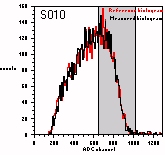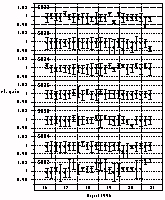Dynamic gain calibration
Introduction
Unlike other experiments, the Pion-Beta Experiment is not using
a light pulser for gain stabilization. Instead, Michel events are
taken during normal runs. The Michel decay of stopped muons in the
target produce an energy spectrum with a characteristic edge at
about 50 MeV in the CsI calorimeter. If the gain in some PM tubes
or the light output per MeV of any CsI crystal changes over time,
this edge is shifted.
The task of the dynamic gain calibration is to analyze the michel
spectra on a periodical basis and produce a gain drift table. If
the gain of any channels drifts more than a certain value, the
high voltage of that channel has to be adjusted.
Theory of operation
Besides Pi-Beta and pi+ -> e+ nu events, data is taken for
a prescaled number of michel events at a rate of about 100 events
per second. These events are identified by a specific bit pattern
in the event data and histogrammed separately from other event
types. For each channel, a histogram is updated with the sum
of all CsI ADC's, if that specific channels contains more than
70% of the total energy. If the histograms contain a given number
of events, they are compared with a saved set of reference
histograms. The reference histograms were taken at an initial
calibration run. The actual histograms are scaled by an variable
gain factor g, which is varied to minimize the mean quadratic
deviation between the reference histogram r[i] and the actual
histogram h[i]:
 The factor g is varied from 0.8 to 1.2 in small steps to
find the minimum deviation. The error of this determination is
given by the range where chi^2 increases by one. To minimize the
error, the two histograms are only correlated in a region which
shows a pronounced feature, because the method doesn't work at
regions which are flat. Therefore, a region around the michel
edge was chosen which gives a minimal error.
The factor g is varied from 0.8 to 1.2 in small steps to
find the minimum deviation. The error of this determination is
given by the range where chi^2 increases by one. To minimize the
error, the two histograms are only correlated in a region which
shows a pronounced feature, because the method doesn't work at
regions which are flat. Therefore, a region around the michel
edge was chosen which gives a minimal error.
Results
During our 1996 beam time, one week was dedicated for long term
stability tests. During this week, Michel events were taken
coninuously at a rate of 30Hz. Every five hours, the gains were
calibrated against reference histograms taken at the beginning of
this week. Following picture shows the Michel spectra from
the beginning (red) and end of this week (black). The grey region
around the Michel edge was used by the gain matching alorithm.
Note how accurate the Michel edges fall together. No significant
gain deviation can be observerd.

The next picture shows another channels, which shows a significant
gain drift of +2.2%:

A compilation of all channels from the 1996 beam time is shown
here:


Except in channel 32 no significant gain drift was observable over
the period of one week. This shows that the energy resolution of
our detector is stable at the per cent level over a long time
and no dynamic high voltage adjustment as planned originally is
necessary.

S. Ritt, 31 Oct 1995


